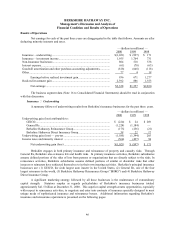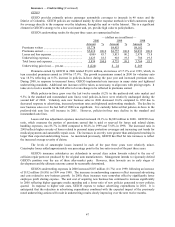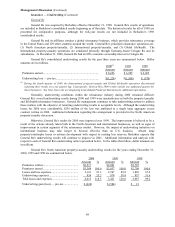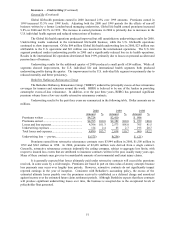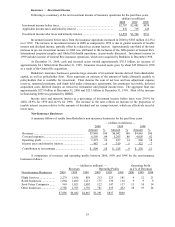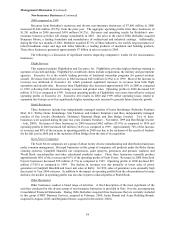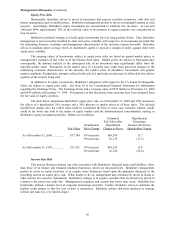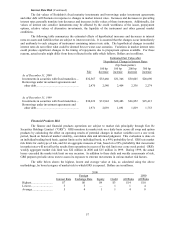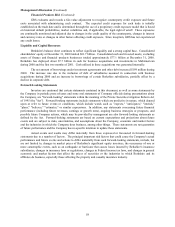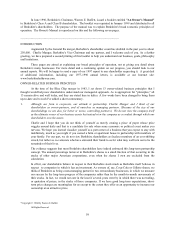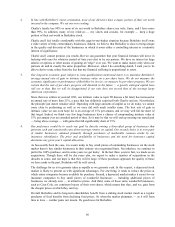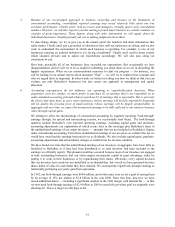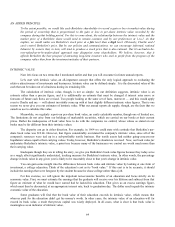Berkshire Hathaway 2000 Annual Report Download - page 57
Download and view the complete annual report
Please find page 57 of the 2000 Berkshire Hathaway annual report below. You can navigate through the pages in the report by either clicking on the pages listed below, or by using the keyword search tool below to find specific information within the annual report.
56
Management’s Discussion (Continued)
Equity Price Risk
Strategically, Berkshire strives to invest in businesses that possess excellent economics, with able and
honest management and at sensible prices. Berkshire's management prefers to invest a meaningful amount in each
investee. Accordingly, Berkshire's equity investments are concentrated in relatively few investees. At year-end
2000 and 1999, approximately 70% of the total fair value of investments in equity securities was concentrated in
four investees.
Berkshire's preferred strategy is to hold equity investments for very long periods of time. Thus, Berkshire
management is not necessarily troubled by short term price volatility with respect to its investments provided that
the underlying business, economic and management characteristics of the investees remain favorable. Berkshire
strives to maintain above average levels of shareholder capital to provide a margin of safety against short term
equity price volatility.
The carrying values of investments subject to equity price risks are based on quoted market prices or
management's estimates of fair value as of the balance sheet dates. Market prices are subject to fluctuation and,
consequently, the amount realized in the subsequent sale of an investment may significantly differ from the
reported market value. Fluctuation in the market price of a security may result from perceived changes in the
underlying economic characteristics of the investee, the relative price of alternative investments and general
market conditions. Furthermore, amounts realized in the sale of a particular security may be affected by the relative
quantity of the security being sold.
In addition to its equity investments, Berkshire's obligations with respect to the 1% Senior Exchangeable
Notes are subject to equity price risks. See Note 10 to the Consolidated Financial Statements for information
regarding the Exchange Notes. The Exchange Notes had a carrying value of $235 million at December 31, 2000
and $449 million at December 31, 1999. For purposes of this discussion, these amounts have been deducted from
the fair value of equity securities.
The table below summarizes Berkshire's equity price risks as of December 31, 2000 and 1999 and shows
the effects of a hypothetical 30% increase and a 30% decrease in market prices as of those dates. The selected
hypothetical change does not reflect what could be considered the best or worst case scenarios. Indeed, results
could be far worse due both to the nature of equity markets and the aforementioned concentrations existing in
Berkshire's equity investment portfolio. Dollars are in millions.
Estimated Hypothetical
Fair Value after Percentage
Hypothetical Hypothetical Increase (Decrease)
Fair Value Price Change Change in Prices Shareholders’ Equity
As of December 31, 2000................ $37,384 30% increase $48,599 11.7
30% decrease 26,170 (11.7)
As of December 31, 1999................ $37,323 30% increase $48,520 12.4
30% decrease 26,126 (12.4)
Interest Rate Risk
This section discusses interest rate risks associated with Berkshire’s financial assets and liabilities, other
than those of its finance and financial products businesses, which are discussed later. Berkshire's management
prefers to invest in equity securities or to acquire entire businesses based upon the principles discussed in the
preceding section on equity price risk. When unable to do so, management may alternatively invest in bonds or
other interest rate sensitive instruments. Berkshire's strategy is to acquire securities that are attractively priced in
relation to the perceived credit risk. Management recognizes and accepts that losses may occur. Berkshire has
historically utilized a modest level of corporate borrowings and debt. Further, Berkshire strives to maintain the
highest credit ratings so that the cost of debt is minimized. Berkshire utilizes derivative products to manage
interest rate risks to a very limited degree.


